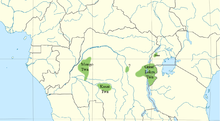- Mongo Twa
-
The 14,000 Twa (locally Cwa [tʃwa]) of the swamp forest north and west of Lake Tumba and between Tumba and Lake Mai-Ndombe in the west of the Congo are one of several fishing and hunter-gatherer castes living in a patron–client relationship with farming Bantu peoples across central and southern Africa. In this case the people are the Mongo, specifically the Mongo tribes known as Ntomba,[1] Lia (Bolia),[2] and Konda;[3] the two castes are called Oto and Twa. The Oto are the agricultural patrons of the Twa.
Game is easiest for the Twa to hunt in the rainy season, the period of seasonal hunger, as the flooded rivers force them to high ground near the villages, which are separated by the marshes. They exchange the game for cassava, palm oil, iron, and pottery. Unlike further south, it is the patron Oto who do the fishing. The Twa are however being forced to settle, as their foraging territory is being cleared for farming (Pagezy).
There is little mixing between the castes. On the rare occasion that an Oto man has a child with a Twa woman, the child is raised as Twa. This is in contrast to the Mbenga and Mbuti, where village men commonly take Pygmy wives, and the child grows up in the village (Hiernaux).
Normally the name "Twa" is used alone, but when disambiguation is required, they may be called the Mongo Twa, Konda Twa, Lia Twa, Ntomba Twa.[4]
Notes
- ^ Likely Ntomba-language speakers, who live around the lake, though dialects of Mongo proper are also called Ntomba
- ^ Ntomba and Lia are possibly dialects
- ^ Konda may also be divergent enough to be considered a distinct language.
- ^ Pujol & Laurens, 1975. L'Homme et l'animal: premier Colloque d'ethnozoologie, p 63;
Hiernaux, p 202
References
- Hiernaux, Jean. 1977. "Adaptation of the African to the rain forest", in Harrison (ed.) Population Structure and Human Variation
- Pagezy, H. 1988. "Coping with uncertainty in food supply among the Oto and Twa living in the equatorial flooded forest near Lake Tumba, Zaire." In de Garine & Harrison (eds.), Coping with Uncertainty in Food Supply, pp 175–209. Clarendon.
See also
- Twa peoples
- Classification of Pygmy languages
Categories:- African Pygmies
- Ethnic groups in the Democratic Republic of the Congo
Wikimedia Foundation. 2010.

